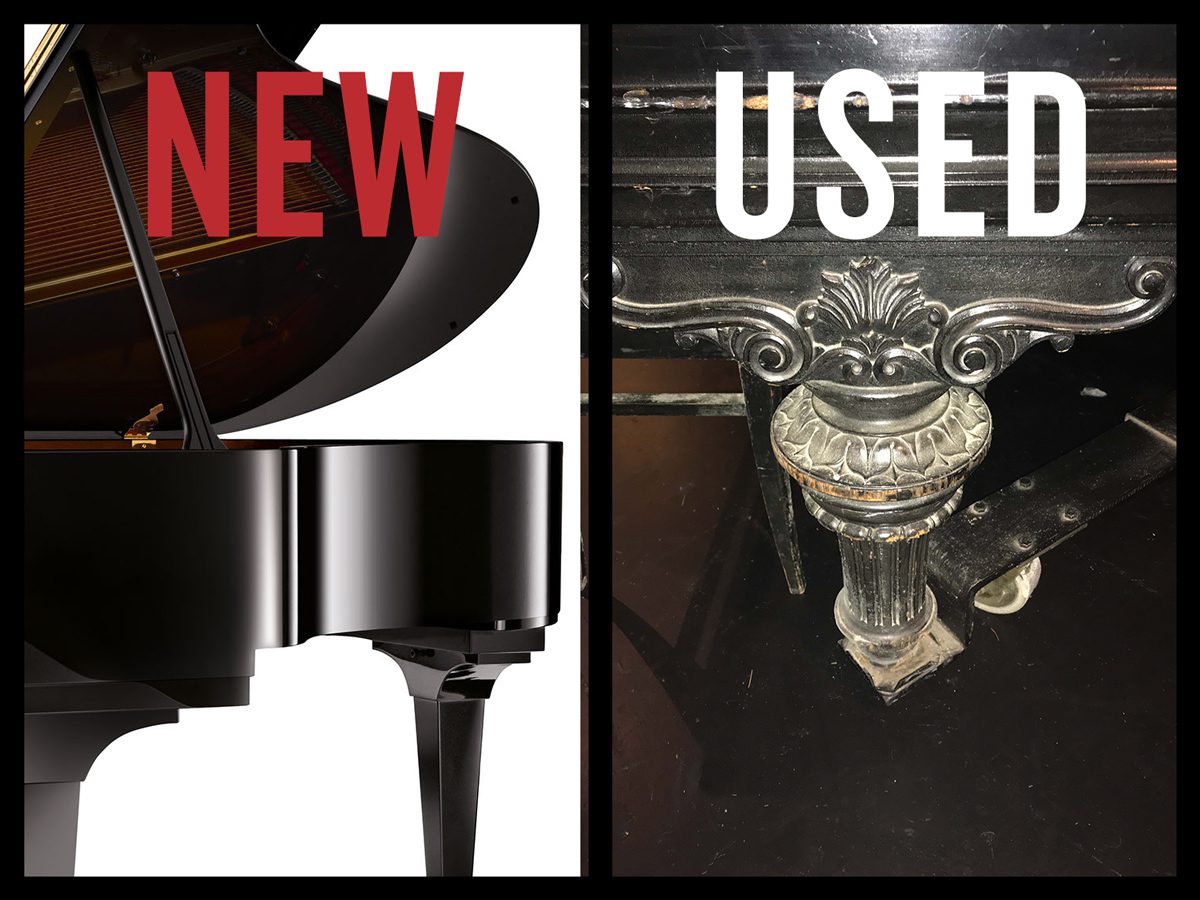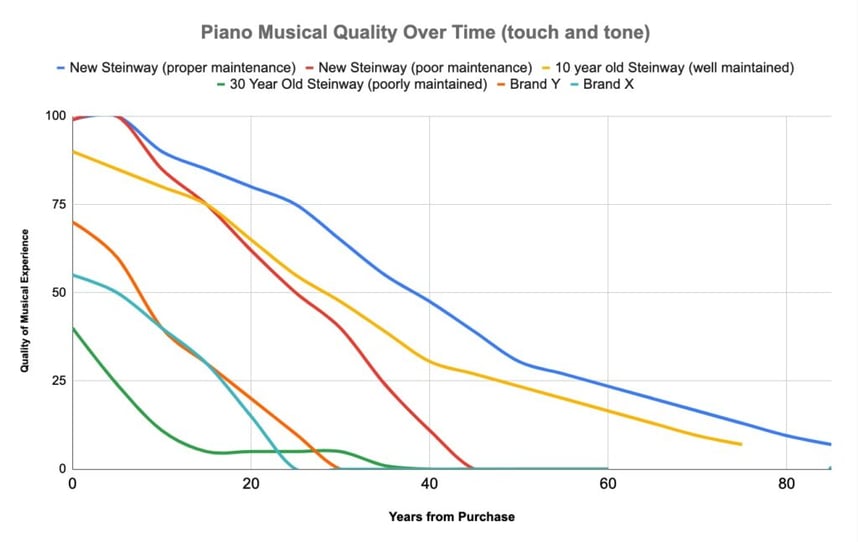New vs Used Steinway
April 7, 2020 •Chuck Johnson
Updated February 2022

You’re considering buying a Steinway piano, and have heard differing opinions on the merits of new vs. used. M. Steinert & Sons offers both new and used Steinway pianos, and we are frequently called upon to help our customers make this choice. Having played the piano for 48 years, and worked in the piano industry for 30 of those years, I still find it surprising there are few agreed-upon facts, especially when it comes to a new and used Steinway!
Let's explore when both new AND used Steinways make sense - and admit upfront the answer could be "neither". Before spending thousands of dollars, you need to make sure that you’re making a sound decision.
Our goal with this article is to teach you what you need to know about buying the right piano for you based on the best information available.
Fact #1: All pianos degrade with time - even Steinways.
While time takes a toll on all organic materials, the piano's overall design makes it particularly susceptible to aging. Unlike other stringed instruments, the percussive nature of the piano hastens wear-and-tear. This erosion comes from three things:
- Tension: The piano produces sound thanks to the tension inherent in its design. The strings continuously bear down on the bridges and soundboard – constantly pushing downward with about 720 lbs of pressure—the average weight of about 3 NFL linebackers standing on the soundboard for life. This pressure over the years forces the soundboard downwards – resulting in loss of crown and bearing and a resultant change in tone. (Crown and bearing are terms used by piano technicians to describe the height of the string at the bridge relative to the rest of the string.)
- Wear: Wear is a function of actual playing time - which will vary between users. Think of the differences between a middle school chorus room piano and one that holds pictures in a living room. All piano parts have an impact on the overall sound and performance of the instrument. Some pianos have over 50 parts per key - which could mean up to 12,000 total parts in some. Over time, hammers compress and become hardened, bushings get sloppy, tuning pins loosen from tunings, and hundreds of key parts become looser and worn with use. Soundboards often develop cracks (though not always catastrophically).
- Environment: During construction, the storage and lifetime use(s) of the piano are the big unknowns. The environment that your piano is in can create variations in temperature and humidity, leaving the wood to undergo alternative swelling and contracting. While this tends to subside in a given location, the effects of moving a piano between any locations are hard to predict. There is consistent agreement within the piano industry that the environment is a significant contributor to overall degradation.
There are a lot of myths about old pianos out there - but with very few exceptions (of historic/artistic value), old pianos will become virtually worthless and musically inert in time - EVEN STEINWAY PIANOS.
We've developed a way to explain the effects of time on pianos. This explanation is BRAND AGNOSTIC.
Fact #2: Each instrument has a curve of quality over time.
Every piano exists on a curve of musical quality over time. This is a highly subjective area! It would be hard to get two people in the piano industry to agree on the curve for a brand, model, or even a specific Steinway piano. However, it doesn't change the reality that all pianos begin at their best (or very close to it) and then lose tone and touch over time. The severity of the instrument's decline is determined by the design and factors mentioned above (Tension, Wear, Environment).

This all begs an important question: Where is my piano on the curve??
Each piano will start decaying at some point - but when, where, and how is extraordinarily difficult to determine. Most people find that the only way to assess a used piano's condition accurately is to play it vigorously and to hire an independent and reputable piano technician - one NOT connected to a store or the seller. It is equally vital to understand some technicians will do these evaluations in hopes of offering rebuilding services. This makes it very hard to find an unbiased participant to evaluate the quality of a used piano.
Pros and Cons of New and Used Steinway Pianos
Pros of a New Steinway Piano:
- You can pick the size, model, and preferred sound/touch.
- There's no question about its past. It's got its full life ahead of it.
- Manufacturer Warranty Support.
- The only pianos with Spirio option.
- New Diamondgloss finish is standard.
- Many factory improvements have been made in the past ten years, making modern Steinways much better and more consistent than old ones.
Cons of a New Steinway Piano:
- It costs more, at least in the beginning... (there's no denying it).
Pros of Used Steinway:
- It still says Steinway on it.
- It costs less in the beginning.
- If less than 10-20 years old - may have significant life remaining.
Cons of Used Steinway:
- Depending upon age - missing key Steinway patents/innovations that yielded the Steinway reputation.
- Not knowing about the nature and quality of work done over time.
- Who did the maintenance/work?
- Was a restoration done, what exactly did they do, and where did they get the parts?
- Are they authentic Steinway parts? (Note: ONLY Steinway installs Steinway soundboards and pinblocks).
- A potential unknown number of owners/users.
- Lack of credible warranty support.
- Value and price confidence, it's a much riskier purchase overall than a new one.
How to Choose Between a New and Used Steinway Piano
Spending 10 to 40 thousand dollars on any used piano is a lot of money and yields considerable uncertainty. So if buying a new Steinway is financially possible for you, it's almost always worth the peace of mind in the long run. Used is tempting, but you need to get to know the piano very well before making any investment.
A Used Steinway typically fits those who:
- Have a budget of $30,000-$90,000
- Just want the name Steinway.
- Have a skilled and trusted technician to help evaluate options.
- Prepared to invest in required maintenance and deal with hassles of older pianos.
A New Steinway works well if you:
- Can allocate $86,000 or more to a grand piano purchase.
- Want the recognized best in class.
- Demand all the latest improvements from Steinway and the new high-polish DiamondGloss finish.
- Prefer manufacturer warranty support.
Learn more about new Steinway pianos or visit our used piano department for specific used options.
Footnote on Boston pianos: Many shoppers considering used Steinway learn the nuances of piano design and begin to understand the effects of aging. Steinway designed and built the Boston brand pianos - Steinway's solution for a mid-priced piano that leverages their experience with design, materials, and workmanship.
Featured Articles
Categories
- Beginner Pianos (23)
- Boston Pianos (15)
- Comparisons (30)
- Designer and Specialty Pianos (8)
- Essex Pianos (10)
- Events (11)
- Featured (24)
- Institutional (3)
- Joy of Piano (15)
- Learning About Pianos (69)
- News (35)
- Pricing and Cost (19)
- Resource Center (122)
- Roland Pianos (6)
- Spirio (15)
- Steinway Pianos (70)
- Student (14)
- Teacher (13)
- Used Pianos (20)
- Videos (19)

